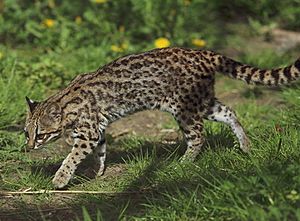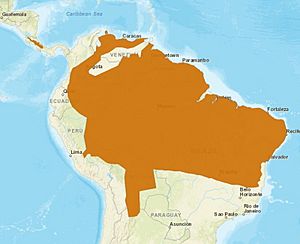Oncilla facts for kids
Quick facts for kids Oncilla |
|
|---|---|
 |
|
| Conservation status | |
| Scientific classification | |
| Genus: |
Leopardus
|
| Species: |
tigrinus
|
 |
|
| Distribution of the Oncilla, 2016 | |
| Synonyms | |
|
Oncifelis tigrinus |
|
The oncilla (Leopardus tigrinus) is a small, spotted wild cat. It is also known as the northern tiger cat, little spotted cat, or tigrillo. This shy cat lives in forests from Central America all the way to central Brazil.
Scientists are still studying if there are different types of oncillas across this huge area. The oncilla is listed as a Vulnerable animal on the IUCN Red List. This means its numbers are decreasing. The main reasons for this are deforestation and its forest home being turned into farms.
Contents
About the Oncilla
The oncilla is a beautiful wild cat. It looks a lot like a small jaguar or leopard. It has a soft, thick coat with dark spots. These spots are called rosettes. They help the oncilla blend in with its forest home.
What Does it Look Like?
Oncillas are quite small. They are usually about 40 to 55 centimeters (16 to 22 inches) long. Their tail adds another 25 to 40 centimeters (10 to 16 inches). An adult oncilla weighs between 1.5 and 3 kilograms (3.3 to 6.6 pounds). That's about the size of a large house cat!
Their fur color can be yellowish-brown or reddish-brown. The spots are dark brown or black. Some oncillas can even be completely black. This is called melanism. It's similar to how some black panthers are actually leopards or jaguars with dark fur.
Where Do Oncillas Live?
Oncillas live in many different types of forests. They can be found in cloud forests, tropical rainforests, and even drier forests. Their home stretches from Costa Rica and Panama in Central America down through Colombia, Ecuador, Peru, and Bolivia. They also live in Brazil, Paraguay, and Argentina.
They prefer areas with thick plant cover. This helps them hide from predators and sneak up on their prey. They are often found in mountainous regions.
What Do Oncillas Eat?
Oncillas are carnivores, which means they eat meat. They are skilled hunters. Their diet mainly includes small animals. They hunt rodents like mice and rats. They also eat birds, lizards, and frogs.
Sometimes, they might even catch larger prey. This could include small monkeys or other small mammals. They hunt mostly at night. Their excellent eyesight and hearing help them find food in the dark.
How Do Oncillas Behave?
Oncillas are mostly solitary animals. This means they prefer to live alone. They are also nocturnal, which means they are most active at night. During the day, they rest in trees or hidden spots on the ground.
They are very agile climbers. They can move quickly through trees. This helps them escape danger and find food. They use scent marks to communicate with other oncillas. This tells other cats about their territory.
Reproduction and Life Cycle
Female oncillas usually give birth to one or two kittens at a time. The kittens are born after a pregnancy of about 74 to 76 days. They are born blind and helpless.
The mother oncilla takes care of her kittens in a safe den. The kittens grow quickly. They start to explore their surroundings after a few weeks. They learn to hunt from their mother. Young oncillas usually stay with their mother for several months. They learn important survival skills before they go off on their own. Oncillas can live for about 10 to 15 years in the wild.
Protecting the Oncilla
The oncilla faces many threats. The biggest threat is the loss of its habitat. Forests are being cut down for farming, logging, and building. This leaves less space for oncillas to live and find food.
Hunting is another problem. Oncillas are sometimes hunted for their beautiful fur. However, hunting them is illegal in most places. Conservation groups are working hard to protect oncillas. They are trying to save their forest homes. They also educate people about the importance of these amazing cats.
By protecting the oncilla, we also help protect the many other animals and plants that share its forest home.
See also
 In Spanish: Tigrillo para niños
In Spanish: Tigrillo para niños


